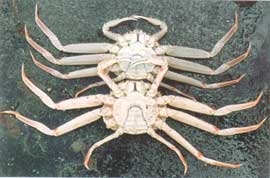 February 15, 2006
This summer, a team of Alaska Fisheries Science Center biologists continued their scrutiny of bitter crab syndrome (BCS), a disease affecting a variety of crab species worldwide. BCS is caused by a single-celled parasitic dinoflagellate of the Hemotodinium species. In contrast, non-parasitic dinoflagellates are important members of plankton communities and contribute to primary productivity of the world's oceans.
In Alaska, the disease is known to occur in Snow crab, Chionoecetes oplio, in the Bering Sea, Chukchi Sea, and Norton Sound, and in Tanner crab, C. bairdi, in Southeast Alaska, the Gulf of Alaska, and the Bering Sea. BCS is not dangerous to humans, but renders crab flesh unappetizing. Heavily diseased crab, when cooked, takes on a chalky texture and tastes bitter. BCS is fatal to crabs. "We hope to determine the life history of this parasite," said Dr. Frank Morado who leads a research team from the Alaska Fisheries Science Center. "This research will teach us more about how the parasite survives and spreads. That is the purpose behind our work with Alaska Department of Fish & Game biologists in Southeast Alaska, an area known to have regions of high BCS occurrence." Crab fishermen can usually identify crabs heavily infected with BCS. Diseased crabs usually exhibit a discolored carapace, which may become abnormally bright pink or opaque, rather than translucent; milky white hemolymph (the equivalent of blood); and lethargic behavior. All crab sizes are affected by the disease. Data from trawl surveys suggest that there is a higher prevalence of BCS among small crabs, which could drastically impair recruitment and recovery of the species. The infection proliferates in crab populations during the summer months when the water is warmer. Conversely, disease mortality decreases to zero during the winter months. Scientists do not yet understand all of the possible benthic changes that may increase the potential for proliferation of the disease. A related parasite is also found in the blue crab of the east coast. Studies there indicate that areas of high salinity or slow water flow may contribute to the spread of the disease. No such relationship has been documented or observed in the North Pacific. Scientists will also examine whether the disease can be delivered through water or through sediments as crabs bury themselves. This past October, Vanessa Lowe of the research team again participated in the first leg of the 2005 Alaska Department of Fish and Game Southeast Alaska Tanner crab survey. Hemolymph was collected from randomly sampled crabs. In addition, sediment and water samples were collected from low and high BCS prevalence areas. Hemolymph was collected for the purpose of detecting and monitoring disease prevalence using a recently developed PCR-based assay. This protocol is more sensitive in detecting BCS and less time consuming than traditional examination of blood-smears. The same protocol will be applied to water and sediment samples in the hope that the life history of the parasitic dinoflagellate can be characterized. The research team is also conducting DNA sequencing to determine the relation of the North Pacific parasitic dinoflagellate with other similar parasites.
Source of News & Photo:
Publish A Letter on SitNews Read Letters/Opinions
|
||
